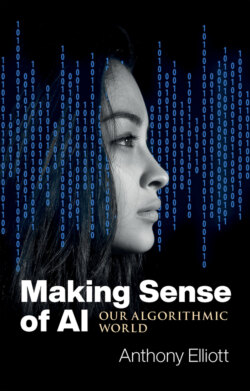Making Sense of AI

Реклама. ООО «ЛитРес», ИНН: 7719571260.
Оглавление
Anthony Elliott. Making Sense of AI
Table of Contents
Guide
Pages
Making Sense of AI. Our Algorithmic World
Copyright Page
Preface
1 The Origins of Artificial Intelligence
What is Artificial Intelligence?
Frontiers of AI: Global Transformations, Everyday Life
Complex Systems, Intelligent Automation and Surveillance
Notes
2 Making Sense of AI
Two Theoretical Perspectives: Sceptics and Transformationalists. Sceptics
Transformationalists
Box 2.1 Sceptics
Box 2.2 Transformationalists
The Perspectives Compared
Integrating the Insights
Notes
3 Global Innovation and National Strategies
World Leaders: USA, China and Globalization
The USA
China’s AI Ambitions
The World Leaders Compared
The EU and European Developments
Finland
Poland
The UK
Outliers: UAE, Japan and Australia
Notes
4 The Institutional Dimensions of AI
Complex Adaptive Systems and AI
The Increasing Scale of AI
Path-Dependent Connections: New and Old Technologies
The Globalization of AI Technologies and Industries
The Diffusion of AI in Institutional and Everyday Life
AI and Complexity
The Penetration of AI into Lifestyle Change and the Self
AI, Surveillance and the Transformation of Power
Human–Machine Interfaces and Coactive Interactions
Complex Systems
Human–Machine Interfaces
Interfaces and the Changing Location of Social Actors
Notes
5 Automation and the Fate of Employment
Robots Replacing Jobs: AI, Automation, Employment
Automated Professions, Robot Managers
Globalization, Globots and Remote Intelligence
Empowerment: Education, Reskilling, Retraining
Notes
6 Social Inequalities Since AI
Automating Social Inequalities
Ghosts in the Machine: Racist Robots
AI and Gender Troubles
Digital Inequalities: Chatbots and Social Exclusion
Notes
7 Algorithmic Surveillance
The Digital Revolution and Panoptic Surveillance
After Super-Panopticon: Surveillance Capitalism
Military Power: Drones, Killer Robots and Lethal Automated Weapons
Notes
8 The Futures of AI
The Future Now: COVID-19 and Global AI
Automated Societies: Networked Artificial Life
The Year 2045: The Technological Singularity
AI Climate Futures
Algorithmic Power and Trust
Notes
Further Reading
Index
POLITY END USER LICENSE AGREEMENT
Отрывок из книги
Anthony Elliott
Some research reported in this book was supported by the Australian Research Council grants ‘Industry 4.0 Ecosystems: A Comparative Analysis of Work–Life Transformation’ (DP180101816) and ‘Enhanced Humans, Robotics and the Future of Work’ (DP160100979). Other research not explicitly detailed, but upon which I draw implicitly in the argumentation of the book, includes my recent European Commission Erasmus+ grants ‘Discourses on European Union 14.0 Innovation’ (611183-EPP-1-2019-1-AU-EPPJMO-PROJECT) and Jean Monnet Network ‘Cooperative, Connected and Automated Mobility’ (599662-EPP-1-2018-1-AU-EPPJMO-NETWORK). Many thanks to the funding agencies which have supported this research. Huge thanks to my wonderful colleagues at the Jean Monnet Centre of Excellence at the University of South Australia, especially Louis Everuss and Eric Hsu. Ross Boyd assisted with the preparation of the manuscript, and was marvellously helpful in making many suggestions that I was able to directly incorporate into the text. At Keio University in Japan, where I regularly visit as part of the Super-Global Program, my thanks as ever to Atsushi Sawai. At University College Dublin, where I also regularly visit, my thanks to Iarfhlaith Watson and Patricia Maguire.
.....
Many studies have cast globalization solely as an economic phenomenon. From this angle, globalization consists of the ever-increasing integration of economic activity and financial markets across borders. Some analyses have emphasized that globalization is the driver of economic neoliberalism, privatization, deregulation, speculative finance and the crystallization of multinational corporations operating across the borderless flows of the global economy.11 It is obvious that such an image of globalization is well geared to rendering AI as simply an upshot of the corporate activities of IBM, Amazon, Google, Microsoft and Alibaba. Other writers have argued that globalization is synonymous with Americanization. AI here is viewed as a set of effects brought about by powerful actors, academic research institutes and industry labs, administrative entities and political forces promoting the Americanization of the world. Much AI research, as we will examine throughout this book, has indeed been funded by the American government, especially the US Department of Defense. Consider, for example, the extensive role of the Defense Advanced Research Projects Agency (DARPA), which during the 1960s poured millions of dollars into the establishment of AI labs at MIT, Carnegie Mellon University and Stanford University along with commercial AI laboratories including SRI International. As I discuss in some detail in chapter 3, the influence of the US Department of Defense upon the digital revolution was hugely consequential and brought in its train a global extension of emergent markets for artificial intelligence.
And so we come back to the big issue of who exactly commissioned the major AI projects that were launched in the 1950s and 1960s. Who was paying for the key AI research breakthroughs? What forms of power were these early commissions advancing and reinforcing? Obviously there were many divergent interests, although the history of the funding cycles around AI clearly suggests that nation-states (especially the United States and, to a much more limited extent, the United Kingdom) along with the biggest multinational companies were the principal actors. Beyond nation-states and corporations, however, another dimension of AI concerns the world military order. Understanding the connections between the techno-industrialization of war, automated techniques of military organization and the flow of AI technologies is very important to grasping the globalizing of AI. I seek to highlight these issues in terms of an institutional account of what I shall call algorithmic modernity, developed with reference to the operations of advanced capitalism, lifestyle change, social inequalities and surveillance, throughout the book as a whole. For the moment, however, it is notable that many of the early successes, as well as some fairly dramatic failures, in AI can be traced to overlaps between military power and the development of automated intelligent machines.
.....